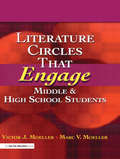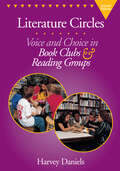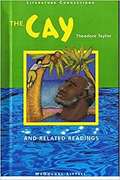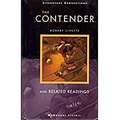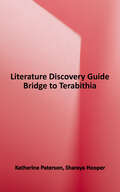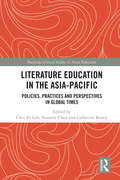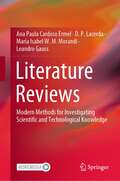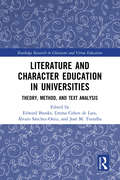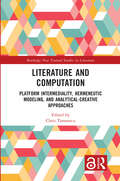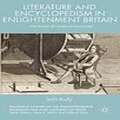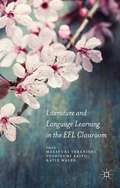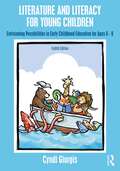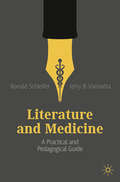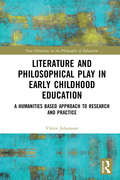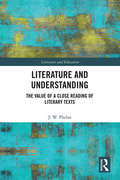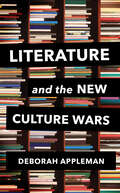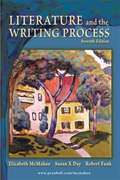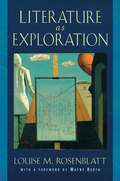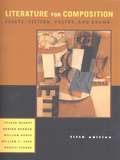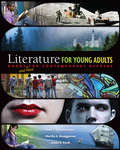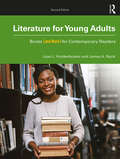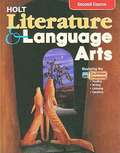- Table View
- List View
Literature Circles That Engage Middle and High School Students
by Victor Moeller Marc MoellerEngage your students with Literature Circles! This book will show you how to prepare your students to lead their own active, focused discussion in small groups. Give your students the tools to engage with books and with each other. You can even incorporate film versions of classic texts into discussion.
Literature Circles: Voice and Choice in Book Clubs & Reading Groups
by Harvey DanielsWhat do we know about literature circles now that we didn't understand eight or ten years ago? What new resources and procedures can help teachers organize their classroom book clubs better? What are the most common pitfalls in implementing student-led discussion groups? And getting beyond the basics, what do mature or advanced literature circles look like? In this thoroughly revised and expanded guide, you will find new strategies, structures, tools, and stories that show you how to launch and manage literature circles effectively. Advanced variations are explored and include alternatives to role sheets and flexible new guidelines for their use. The second edition includes: four different models for preparing students for literature circles using response logs, sticky notes, and newly designed role sheets;dozens of variations on the basic version of student-led bookclubs;new models and procedures for primary, intermediate, and high school grades;new materials for assessing and grading literature circles;an inventory of common management problems and solutions;new scheduling patterns for group meetings and reading time;ideas for using literature circles with nonfiction texts across the curriculum;research on literature circles, including correlation with increased achievement on standardized tests;an explanation of how literature circles match with the national standards for literacy education.With detailed examples provided by twenty practicing teachers, Harvey Daniels offers practical and concrete suggestions for each aspect of book club management and proven solutions for problems that arise.
Literature Discovery Guide Bridge to Terabithia
by Katherine Paterson Sharaya HooperBlackbird & Company literature discovery guides have been developed with the fundamental belief that the emotional, intellectual, and spiritual components of a story are inseparable. Stimulating the heart, mind, and soul is essential to a full literary experience. When we recognize and embrace the truth that a great multitude of language arts standards are met while digging into literature, basing the language arts program on books makes sense. Transforming the language arts program by establishing a tradition of literary exploration has profound results. Blackbird & Company literature discovery guides enable students to independently analyze and respond to great stories while freeing up the teacher's schedule to read and discover alongside their students. Empowering teachers to become mentors releases them from the confines of a tedious, and often frustrating, language arts schedule and affords golden opportunities to nurture the child's heart and mind.
Literature Education in the Asia-Pacific: Policies, Practices and Perspectives in Global Times (Routledge Critical Studies in Asian Education)
by Catherine Beavis Chin Ee Loh Suzanne S. ChooThe continual rise of English as a global lingua franca has meant that English literature, both as a discipline and as a tool in ESL and EFL classrooms, is being used in varied ways outside the inner circle of English. This edited collection provides an overview of English literature education in the Asia-Pacific in global times, bringing to international attention a rich understanding of the trends, issues and challenges specific to nations within the Asia-Pacific region. Comprising contributions from Australia, China, Hong Kong, India, Indonesia, Malaysia, Philippines, Singapore and Vietnam, the collection addresses the diversity of learners in different national, cultural and teaching contexts. In doing so, it provides insights into historical and current trends in literature education, foregrounds specific issues and challenges in policymaking and implementation, presents practical matters concerning text selection, use of literature in the language classroom, innovative practices in literature education, and raises pressing and important questions about the nature, purpose and importance of literature education in global times.
Literature Packet for Persuasion
by Center for Gifted EducationThis book is a fine selection of Literature that are excerpts from various renowned authors' works.
Literature Reviews: Modern Methods for Investigating Scientific and Technological Knowledge
by Ana Paula Cardoso Ermel D. P. Lacerda Maria Isabel Morandi Leandro GaussThis book begins by introducing the topic of knowledge in literature, including its scientific foundations. Due to the ever-increasing number of scientific publications, literature reviews are becoming more and more essential to stay updated. Literature Reviews describes an innovative system for creating systematic literature reviews, through reviewing, analyzing, and synthesizing scientific and technological literature. It then discusses systematic literature reviews, content analysis, and literature synthesis separately, before presenting the methodology to combine them in one process. It showcases computational tools to aid in this technique and offers examples of the method in action. Finally, the book takes a new of future developments in the subject. This book is of interest to graduate students, as well as researchers and academics, helping them to deepen insights and improve skills needed to conduct thorough literature reviews.
Literature and Character Education in Universities: Theory, Method, and Text Analysis (Routledge Research in Character and Virtue Education)
by Edward BrooksLiterature and Character Education in Universities presents the potential of literary and philosophical texts for character education in modern universities. The book engages with theoretical and practical aspects of character development in higher education, combining conceptual discussion of the role of literature in character education with applied case studies from university classrooms. Character education within the academic context of the university presents unique challenges and opportunities. Literature and Character Education in Universities presents perspectives from academics in Europe, the USA and Asia, offering unique insights into the ways that engaged reading and discussion of core texts can promote the development of intellectual and moral virtues. Chapters draw on a wide range of texts from Confucius’ Analects to J. D. Salinger’s The Catcher in the Rye, focusing on themes such as truthfulness, self-knowledge, prudence, tolerance, friendship, and humility. Literature and Character Education in Universities will be of real use to researchers, academics and postgraduates in the fields of higher education, philosophy, and literature. It should be essential reading for university educators interested in character development and advocates of literary education in modern universities.
Literature and Computation: Platform Intermediality, Hermeneutic Modeling, and Analytical-Creative Approaches (Routledge New Textual Studies in Literature)
by Chris TanasescuLiterature and Computation presents some of the most relevantly innovative recent approaches to literary practice, theory, and criticism as driven by computation and situated in digital environments. These approaches rely on automated analyses, but use them creatively, engage in text modeling but inform it with qualitative[-interpretive] critical possibilities, and contribute to present-day platform culture in revolutionizing intermedial ways. While such new directions involve more and more sophisticated machine learning and artificial intelligence, they also mark a spectacular return of the (trans)human(istic) and of traditional-modern literary or urgent political, gender, and minority-related concerns and modes now addressed in ever subtler and more nuanced ways within human-computer interaction frameworks. Expanding the boundaries of literary and data studies, digital humanities, and electronic literature, the featured contributions unveil an emerging landscape of trailblazing practice and theoretical crossovers ready and able to spawn and/or chart the witness literature of our age and cultures.
Literature and Encyclopedism in Enlightenment Britain
by Seth RudyAt a moment when Google seeks "to organize the world's information and make it universally accessible and useful," this book tells the story of long-term aspirations, first in ancient epic and then in a wide range of literary and non-literary works from the early modern era and British Enlightenment, to comprehend, record, and disseminate complete knowledge of the world. It is also a story of the persistent failure of these aspirations, their collapse in the late eighteenth century, and the subsequent redefinition of completeness in modern literary and disciplinary terms. The book argues that the pursuit of complete knowledge advanced the separation of epic from encyclopedia, literature from "Literature," and the sciences from the humanities; it demonstrates that the distinctions between "high" and "low," ephemeral and eternal, useful and useless that persist today all stem from the concepts of completeness that emerged during and as a result of the Enlightenment.
Literature and Language Arts: Introductory Course
by Holt Rinehart Winston StaffRecommended California approved textbook in the language arts.
Literature and Language Learning in the EFL Classroom
by Katie Wales Masayuki Teranishi Yoshifumi SaitoThis book examines how literary texts can be incorporated into teaching practices in an EFL classroom. It takes a multi-faceted approach to how English language teaching and learning can best be developed through presentation and exploration of literary texts.
Literature and Literacy for Young Children: Envisioning Possibilities in Early Childhood Education for Ages 0 - 8
by Cyndi GiorgisThe 8th edition of this bestselling text provides a framework and instructional strategies for identifying, selecting, and teaching high-quality children’s literature for ages 0–8. This new edition’s emphasis on diverse literature will assist in positively impacting the lives of all young people. Effective instructional approaches for using literature as a teaching tool are coupled with developmentally appropriate methods for sharing literature with young children. This book is a foundational text for graduate and undergraduate students in early childhood education, early literacy, literacy methods, children’s literature, and literature instruction.
Literature and Medicine: A Practical and Pedagogical Guide
by Ronald Schleifer Jerry B. VannattaLiterature and Medicine: A Practical and Pedagogical Guide is designed to introduce narrative medicine in medical humanities courses aimed at pre-medicine undergraduates and medical and healthcare students. With excerpts from short stories, novels, memoirs, and poems, the book guides students on the basic methods and concepts of the study of narrative. The book helps healthcare professionals to build a set of skills and knowledge central to the practice of medicine including an understanding of professionalism, building the patient-physician relationship, ethics of medical practice, the logic of diagnosis, recognizing mistakes in medical practice, and diversity of experience. In addition to analyzing and considering the literary texts, each chapter includes a vignette taken from clinical situations to help define and illustrate the chapter’s theme. Literature and Medicine illustrates the ways that engagement with the humanities in general, and literature in particular, can create better and more fulfilled physicians and caretakers.
Literature and Philosophical Play in Early Childhood Education: A Humanities Based Approach to Research and Practice (New Directions in the Philosophy of Education)
by Viktor JohanssonLiterature and Philosophical Play in Early Childhood Education explores the role of philosophy and the humanities as pedagogy in early childhood educational research and practice, arguing that research should attend to questions about education and growth that concern social structures, individual development, and existential aspects of learning. It demonstrates how we can think of pedagogy and educational practices in early childhood as artistic, poetic, and philosophical, and exemplifies a humanities-based approach by giving literature and artful play a place in shaping the ground of practice and research. The book explores a range of alternative approaches to theory in education and the feasibility of a curriculum of moral values for young children and contains a variety of scenes involving children’s play and involvement with literature and fiction. It portrays how engaging with children’s play can be a philosophical and pedagogical investigation where children’s own philosophising is taken seriously, where children’s thoughts are put on a par with established research and philosophy. Moreover, the book engages with a range of different forms of literature – picture books, novels, auto-fiction, poetry – and develops these as portrayals that serve as a basis for non-theoretical and poetic pedagogical research. Literature and Philosophical Play in Early Childhood Education will be of great interest to academics, researchers, and post-graduate students in the fields of philosophy and education. It will also appeal to upper-level undergraduates, school psychologists, teachers, and therapists.
Literature and Understanding: The Value of a Close Reading of Literary Texts (Literature and Education)
by Jon PhelanLiterature and Understanding investigates the cognitive gain from literature by focussing on a reader’s close analysis of a literary text. It examines the meaning of ‘literature’, outlines the most prominent positions in the literary cognitivism debate, explores the practice of close reading from a philosophical perspective, provides a fresh account of what we mean by ‘understanding’ and in so doing opens up a new area of research in the philosophy of literature. This book provides a different reply to the challenge that we can’t learn anything worthwhile from reading literary fiction. It makes the innovative case that reading literary fiction as literature rather than as fiction stimulates five relevant senses of understanding. The book uses examples of irony, metaphor, play with perspective and ambiguity to illustrate this contention. Before arguing that these five senses of understanding bridge the gap between our understanding of a literary text and our understanding of the world beyond that text. The book will be of great interest for researchers, scholars and post-graduate students in the fields of aesthetics, literary theory, literature in education and pedagogy.
Literature and the New Culture Wars: Triggers, Cancel Culture, and the Teacher's Dilemma
by Deborah ApplemanCan educators continue to teach troubling but worthwhile texts? Our current “culture wars” have reshaped the politics of secondary literature instruction. Due to a variety of challenges from both the left and the right—to language or subject matter, to potentially triggering content, or to authors who have been canceled—school reading lists are rapidly shrinking. For many teachers, choosing which books to include in their curriculum has become an agonizing task with political, professional, and ethical dimensions. In Literature and the New Culture Wars, Deborah Appleman calls for a reacknowledgment of the intellectual and affective work that literature can do, and offers ways to continue to teach troubling texts without doing harm. Rather than banishing challenged texts from our classrooms, she writes, we should be confronting and teaching the controversies they invoke. Her book is a timely and eloquent argument for a reasoned approach to determining what literature still deserves to be read and taught and discussed.
Literature and the Writing Process
by Elizabeth Mcmahan Robert Funk Susan X. DayA literature anthology, rhetoric, and handbook in one. Every chapter of this anthology includes coverage of the writing process to help students write more successfully about literature. The process-oriented instruction shows students how to use writing as a way of studying literature and provides students with the tools to analyze literature on their own. New to this edition: New photographs and images chosen to enhance understanding and appreciation of literature Expanded, updated discussion of researched writing (Chapter 17) Further instruction on the elements of argument and arguing an interpretation (Chapter 2) A new casebook on the poetry and prose of Langston Hughes
Literature as Exploration
by Louise M. RosenblattLouise Rosenblatt's Literature as Exploration has influenced literary theorists and teachers of literature at all levels. This attractive trade paperback edition features a new foreword by Wayne Booth, a new preface and retrospective chapter by the author, and an updated list of suggested readings.In Literature as Exploration, Rosenblatt presents her unique theory of literature and focuses on the immense, often untapped, potential for the study and teaching of literature in a democratic society. The author's philosophy of literature is frequently cited as the first presentation of reader-response theory, but she differs from her successors in emphasizing both the reader and the text. Her "transactional" theory of literature examines the reciprocal nature of the literary experience and explains why meaning is neither "in" the text nor "in" the reader. Each reading is "a particular event involving a particular reader and a particular text under particular circumstances." And teachers of literature, Rosenblatt argues, play a pivotal role in influencing how students perform in response to a text.
Literature for Composition: Essays, Fiction, Poetry and Drama
by Sylvan Barnet Morton Berman William BurtonLiterature for Composition is a versatile anthology which has both diverse selections and excellent coverage of writing instruction. The book begins with six chapters on the reading and writing process, followed by a section on literary works and forms, a section on argument, and a thematic anthology. The new edition features updated casebooks on prominent writers as well as a new mini-casebook on The Titanic.
Literature for Young Adults: Books (and More) for Contemporary Readers
by Brueggeman A. Martha James Rycik Joan L. KnickerbockerYoung adults are actively looking for anything that connects them with the changes happening in their lives, and the books discussed throughout Literature for Young Adults have the potential to make that connection and motivate them to read. It explores a great variety of works, genres, and formats, but it places special emphasis on contemporary works whose nontraditional themes, protagonists, and literary conventions make them well suited to young adult readers. It also looks at the ways in which contemporary readers access and share the works they're reading, and it shows teachers ways to incorporate nontraditional ways of accessing and sharing books throughout their literature programs. In addition to traditional genre chapters, Literature for Young Adults includes chapters on literary nonfiction; poetry, short stories, and drama; cover art, picture books, illustrated literature, and graphic novels; and film. It recognizes that, while films can be used to complement print literature, they are also a literacy format in their own right-and one that young adults are particularly familiar and comfortable with. The book's discussion of literary language--including traditional elements as well as metafictive terms--enables readers to share in a literary conversation with their students (and others) when communicating about books. It will help readers teach young adults the language they need to articulate their responses to the books they are reading.
Literature for Young Adults: Books (and More) for Contemporary Readers
by Joan L. Knickerbocker James A. RycikNow in its second edition, this book explores a great variety of genres and formats of young adult literature while placing special emphasis on contemporary works with nontraditional themes, protagonists, and literary conventions that are well suited to young adult readers. It looks at the ways in which contemporary readers can access literature and share the works they're reading, and it shows teachers the resources that are available, especially online, for choosing and using good literature in the classroom and for recommending books for their students’ personal reading. In addition to traditional genre chapters, this book includes chapters on literary nonfiction; poetry, short stories, and drama; and film. Graphic novels, diversity issues, and uses of technology are also included throughout the text. The book's discussion of literary language—including traditional elements as well as metafictive terms—enables readers to share in a literary conversation with their peers (and others) when communicating about books. This book is an essential resource for preservice educators to help young adults understand and appreciate the excellent literature that is available to them. New to the second edition: New popular authors, books, and movies with a greater focus on diversity of literature Updated coverage of new trends, such as metafiction, a renewed focus on nonfiction, and retellings of canonical works Increased attention to graphic novels and multimodal texts throughout the book eResources with downloadable materials, including book lists, awards lists, and Focus Questions
Literature in the Digital Age
by Adam HammondLiterature in a Digital Age: An Introduction guides readers through the most salient theoretical, interpretive, and creative possibilities opened up by the shift to digital literary forms such as e-books, digital archives, and electronic literature. While Digital Humanities (DH) has been hailed as the 'next big thing' in literary studies, many students and scholars remain perplexed as to what a DH approach to literature entails, and skeptical observers continue to see literature and the digital world as fundamentally incompatible. In its argument that digital and traditional scholarship should be placed in dialogue with each other, this book contextualizes the advent of the digital in literary theory, explores the new questions readers can ask of texts when they become digitized, and investigates the challenges that fresh forms of born-digital fiction pose to existing models of literary analysis.
Literature of Language Arts: Second Course (California Edition)
by Holt Rinehart WinstonThis is a book with a big idea--that you are going to learn a lot about your language. This book came together because of the efforts of lots of people--writers, editors, artists, teachers, and even students like you. The chapters in Part 1 begin with an essay that explains the key standards you'll be mastering in the chapter. Then you'll read several literary selections. Following almost every literary selection, you will find some interesting readings, called informational texts. These might be newspaper or magazine articles, Web pages, instructional manuals, interviews, signs, maps, or other documents. All of these informational texts relate to the piece of literature. For example, after the story "In Trouble," about Gary Paulsen's experiences with sled dogs, you'll find an informational article about some of the breeds of dogs used to pull sleds. Along the way you'll find a lot of help in acquiring new words.
